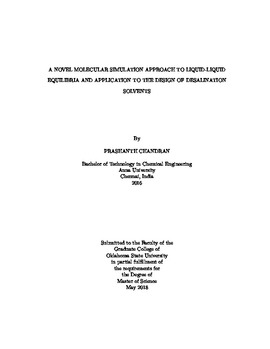| dc.contributor.advisor | Shah, Jindal K. | |
| dc.contributor.author | Chandran, Prashanth | |
| dc.date.accessioned | 2019-03-29T15:39:58Z | |
| dc.date.available | 2019-03-29T15:39:58Z | |
| dc.date.issued | 2018-05-01 | |
| dc.identifier.uri | https://hdl.handle.net/11244/317818 | |
| dc.description.abstract | Conventionally, seawater desalination involves energy-intensive distillation or pressure-driven membrane processes. Recent studies show that directional solvent extraction (DSE) could serve as a viable low-temperature and low-energy alternative. This method utilizes a solvent capable of selectively dissolving water by rejecting the salt ions and at the same time having negligible solubility in water phase followed by the extraction of the dissolved water by heating or cooling the solvent phase. Octanoicacid and decanoic acid have been discovered to serve as a viable candidate for DSE solvent with all the desirable properties. Their studies have shown that these solvent shave very low effectiveness of extracting water and thus need better solvent with good water extracting capacity for making the process more efficient. Such a solvent can be identified by screening molecules capable of extracting higher amount of water than octanoic acid and decanoic acid using a computational approach. Success of such a screening process critically depends on the ability to calculate the solubility of water in solvents and requires a priori prediction of liquid-liquid equilibria of the solvent and water. These calculations remain challenging from molecular simulations due to the difficulties associated with the transfer of molecules between two dense liquid phases. In order to overcome these limitations, a novel molecular simulation methodology is developed based on computing the fugacity of water as a function of concentration to calculate the water dissolution in a range of solvents assuming that the solubility of the solvent is negligible in water. The calculated solubilities are shown to yield good agreement with experimental data for long chain carboxylic acids over a range of temperatures. After developing the method, different solvents were studied which includes branched and fluorinated structures of octanoic acid. Also, the effect of adding alcohol functional group to the molecule at different positions was also studied. Finally, the developed method was also extended to study systems showing mutual solubility in both the directions and was demonstrated using butanol-water system. | |
| dc.format | application/pdf | |
| dc.language | en_US | |
| dc.rights | Copyright is held by the author who has granted the Oklahoma State University Library the non-exclusive right to share this material in its institutional repository. Contact Digital Library Services at lib-dls@okstate.edu or 405-744-9161 for the permission policy on the use, reproduction or distribution of this material. | |
| dc.title | Novel Molecular Simulation Approach to Liquid-Liquid Equilibria and Application to the Design of Desalination Solvents | |
| dc.contributor.committeeMember | Madihally, Sundararajan V. | |
| dc.contributor.committeeMember | Bradshaw, Craig R. | |
| osu.filename | Chandran_okstate_0664M_15695.pdf | |
| osu.accesstype | Open Access | |
| dc.description.department | Chemical Engineering | |
| dc.type.genre | Thesis | |
| dc.type.material | text | |
